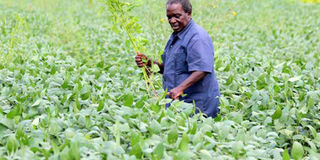Soy beans offer new prospects for Ahero

Meshack Orowo in his Soybeans farm at the Ahero Irrigation Scheme. The farmers have adopted the crop to tame over reliance and dependency of rice as a staple food and subsistence source of income. PHOTO | TONNY OMONDI | NATION MEDIA GROUP
What you need to know:
- Soy beans require a lot of space as they mature into large plants and when grown with other crops it might affect their growth.
- By cultivating soya, the rice farmers reduce over reliance on rice and regenerate the soils.
- Demand for soya in Kenya is estimated at between 50,000 and 70,000 metric tonnes a year while production was at 10,000 metric tonnes last year.
- Soya beans harvested in the dry period are of higher quality than the ones planted in wet seasons.
For 46 years, Mr Meshack Orowo has been growing rice in his four acres of land at Ahero Irrigation Scheme in Kisumu County.
After harvesting, Orowo, like many years farmers would wait for eight months for another planting season, leaving the land fallow.
It never occurred to them that you could plant something else over the period until an agribusiness company introduced soya beans to farmers in the area.
Now Orowo with other 300 farmers do not have to wait for eight months before they plant the next rice crop.
“Soya beans farming will help tame over reliance and dependency on rice both as a staple food and source of income,” said Orowo.
He says unlike rice where they have to seek a market and are exploited by middle men, in the new venture, there is ready market offered by the contracted company.
“The company is in need of seeds and we have the land, we plant the seeds and get our share after they have deducted theirs,” said Orowo.
When Seeds of Gold visited his farm in Ahero, he was cultivating his four weeks old crop which was about to flower.
He says the crops are easy to grow and do not require a lot of water.
“Soybeans are never planted in cold soil temperature as it will prevent them from germinating, the crop does well in humid temperature,” he said
Orowo said when planting rice, the paddy is usually flooded with water unlike soya beans which is only watered in case there are no rains.
NUTRITIOUS AND MEDICINAL VALUE
He said the crop requires a lot of space as they mature into large plants and when grown with other crops it might affect their growth.
“When planting, I set them three feet apart so that they do not compete for space,” he said.
Two to three seeds are placed in a hole after soaking them in a Biofix solution, a fluid that protects the seeds from pests that are likely to feed on them before germinating.
This crop, according to Pamela Owino, another farmer in the area is a bit heavier than rice. For instance, on an acre, she gets 800kg to 1,000kg.
She says soya beans are planted two weeks after harvesting rice, adding that they are provided with a solution which they deep the seeds in before planting.
“After the land is prepared, the seeds are soaked in a Biofix solution provided by the company and then planted later after a day,” said Ms Owino
Farmers are given two varieties, SB24-Mac Soy and SB25-Nam Soy, which are disease resistant and do well in all zones.
“SB24-Mac Soy is used in meat sausage and SB25-Nam Soy in oil products. They both have a lot of nodules and add a lot of nitrogen to the soil,” she says.
The varieties mature in 100 days, faster than the traditional ones that take 120 days. They are very nutritious and have medicinal values.
They are used in making flour, beverages and are recommended for managing high blood pressure.
IMPROVE THE SOIL
She said the company markets and promotes the production of soya beans by offering them advance on funding, land preparation and ploughing, seeds, planting and ready market.
“After harvesting, the same company purchases the seeds from us at a competitive price,” he says.
Orowo says the farmers are given everything for planting on interest-free loan.
“Soya beans requires very little moisture content in the soil and it can survive in humid or sunny season,” says Mr Kennedy Omollo Ogango, a project consultant with Josiche General Traders Limited, which is also involved with initiative.
Demand for soya in Kenya is estimated at between 50,000 and 70,000 metric tonnes a year while production was at 10,000 metric tonnes last year.
The average yield per hectare is between 40 to 60 sacks.
Omollo says scientists are testing about six varieties of soya to find the type that is drought-resistant, tolerant and rust susceptible.
They are also helping farmers in soil testing, improving yields and training them in pest and disease control.
Planting soya beans as a second crop offers numerous advantages to the farmers.
These include the fact that most farmers plant when the rains have ended hence reducing the possibility of distracting the harvest.
“Soya beans harvested in the dry period are of higher quality than the ones planted in wet seasons,” says Omollo
Soya beans, he adds, improve the soil and it can grow in wide range of soils.





